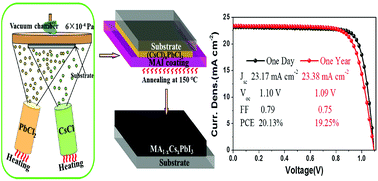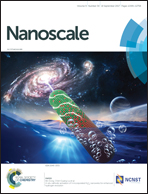Superior stability for perovskite solar cells with 20% efficiency using vacuum co-evaporation†
Abstract
Chemical composition and film quality are two key figures of merit for large-area high-efficiency perovskite solar cells. To date, all studies on mixed perovskites have used solution-processing, which results in imperfect surface coverage and pin-holes generated during solvent evaporation, execrably influencing the stability and efficiency of perovskite solar cells. Herein, we report our development using a vacuum co-evaporation deposition method to fabricate pin-hole-free cesium (Cs)-substituted perovskite films with complete surface coverage. Apart from the simplified procedure, the present method also promises tunable band gap, reduced trap-state density and longer carrier lifetime, leading to solar cell efficiency as high as 20.13%, which is among the highest reported for planar perovskite solar cells. The splendid performance is attributed to superior merits of the Cs-substituted perovskite film including tunable band gap, reduced trap-state density and longer carrier lifetime. Moreover, the Cs-substituted perovskite device without encapsulation exhibits significantly higher stability in ambient air compared with the single-component counterpart. When the Cs-substituted perovskite solar cells are stored in dark for one year, the PCE remains at 19.25%, degrading only 4.37% of the initial efficiency. The excellent stability originates from reduced lattice constant and relaxed strain in perovskite lattice by incorporating Cs cations into the crystal lattice, as demonstrated by the positive peak shifts and reduced peak width in X-ray diffraction analysis.



 Please wait while we load your content...
Please wait while we load your content...